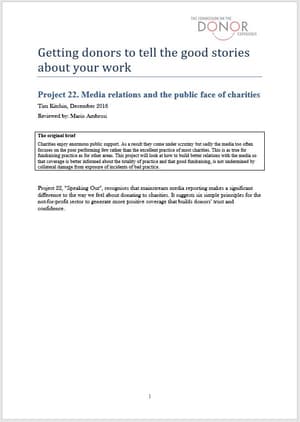CDE project 22: conclusions
- Written by
- The Commission on the Donor Experience
- Added
- April 22, 2017
To grow and thrive, charities must decide to communicate their individual and collective vision confidently to the world. There are plenty of examples of charities doing the right things. Among better known charities, we might call out:
Charity: Water’s elegant, honest project-reporting.
MacMillan’s community engagement efforts.
Cancer Research UK and RSPB’s citizen science projects.
SolarAid’s novel funding approach for solar lanterns.
RNLI’s disruptive embrace of supporter opt-ins.
World Vision’s commitment to rich media through its child sponsorships
British Red Cross’s bold decision to switch off its most interruptive marketing in response to scrutiny.
Where these charities have led, others must follow, respecting their donors, testing out new collaborations with them, and seeking to engage them in a much deeper sense of their shared impact. They must then tell these innovation stories creatively and substantively in order to increase supporters’ trust and confidence.
Leaders, of whatever size or shape, must now step up to co-ordinate a strategic response to the key questions of sustainable funding. These include:
- Can the overall pool of funding actually be grown through a different ‘proposition’ – for example, attracting a greater share of capital growth?
- Can the ever-rising cost of donor acquisition be halted or even reversed?
- What would it take in systems-thinking and action terms to reach these aims?
- What experiments might the sector undertake to validate possible strategies?
Most crucially, of course, the sector must ask itself how it will drive and communicate the impact that merits donor support in the first place.
This is precisely the sort of strategic thinking that is emerging from the Funders Collaboration on Leadership (FCL),9 for example. We need more of this, structurally embedded in how we manage the sector collectively.
FCL’s substantive agenda is focused on:
- Restoring trust in the voluntary sector.
- Sharing foresight information and preparing the sector for the future.
- Improving the standard of governance by informing and skilling trustees.
- Developing a new leadership style for our sector.
The charity sector needs these questions answered - continually.
It is the final suggestion of this work that the charity sector should explore new ways to co-ordinate its future pathfinding by leveraging the particular strengths of existing sector influence hubs such as IoF, NCVO, CAF and ACEVO, building on the excellent work of the Understanding Charities Group, while taking it further still into more ambitious and innovative storytelling.
It is to be hoped that the Commission recognises and promotes the case for better co-ordination within its overall conclusions. Innovation-led and innovation-enabling communication is now vital across all channels, based on substantive sector-wide change.
Precisely how this licence to innovate is ultimately achieved is a topic for further, concerted work.























